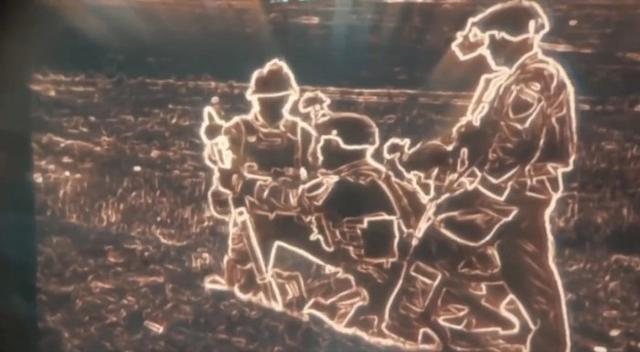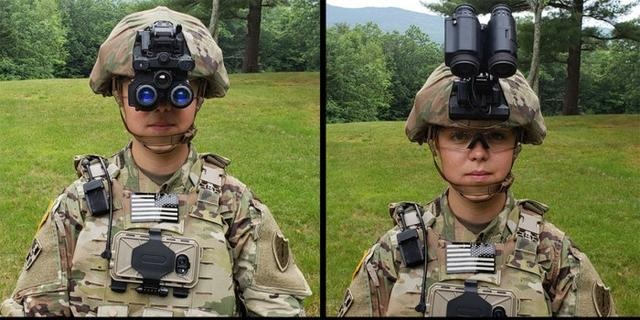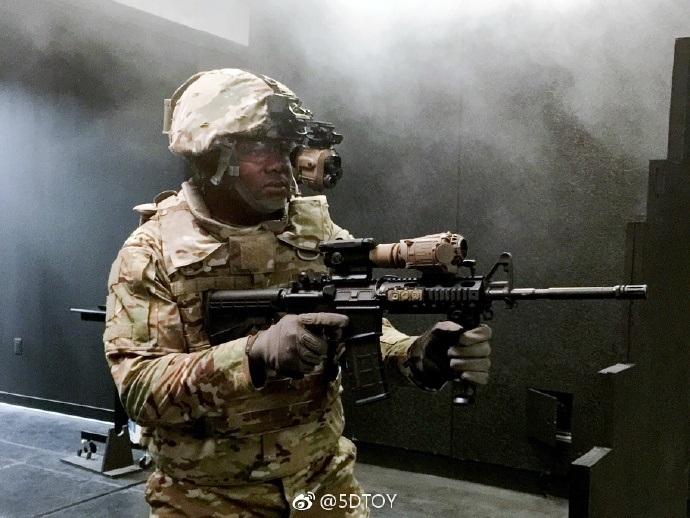| Infantry:Software Enhanced Night Vision
步兵:软件增强夜视功能 Date:2021-08-01 Source:strategypage By:Globalmil Viewed: |
July 26, 2021: American combat troops, especially the infantry, have for centuries been looking for new technology to give them an edge in combat. Until the 1990s this was often expressed as troops modifying their own equipment and weapons, often by borrowing commercial technology. The army had another advantage because its Special Forces, which had been around since the 1950s, had more freedom to try anything new they could get their hands on. The army and marines depended on this Special Forces capability to get successful new tech for all infantry. New technology cooperated in the 1990s by introducing a lot of new tech, usually for civilian markets, that the troops could adopt or adapt to their needs. This trend took off in the 1990s when the army, all-volunteer since the 1970s, got more official support for this bottom-up innovation. After 2001 there was more money, more combat and the Internet to speed up the process still more. In peacetime new developments come more slowly and cannot really be tested as convincingly as during periods of actual combat. After 2001 there was plenty of combat and a lot more tech innovation because troops had more opportunity to quickly determine what worked and what didn’t and share experiences with others via the newly introduced (to a mass audience) Internet.
2021年7月26日:美国作战部队,尤其是步兵,几个世纪以来一直在寻找新技术,让他们在战斗中占据优势。直到20世纪90年代,这通常表现为部队通过借用商业技术来改装自己的装备和武器。军队还有另一个优势,因为自20世纪50年代以来一直存在特种部队有更多的自由来尝试任何他们可以接触到的新事物。陆军和海军陆战队依靠特种部队的这种能力为所有步兵获得成功的新技术。在20世纪90年代通过引入许多新技术进行合作,通常用于民用市场,部队可以采用或适应他们的需求。这种趋势在20世纪90年开始兴起,当时军队自20世纪70年代以来全是志愿人员,对这种自下而上的创新获得了更多官方支持。 自2001年以后有更多的资金,更多的战斗和互联网来加速这个过程。在和平时期,新的发展来得更慢,并且不能像实战时期那样真正经过验证。2001年之后,出现了大量的战斗和更多的技术创新,因为部队有更多机会快速确定哪些有效哪些无效,并通过新引入的(面向大众的)互联网与他人分享经验。
One area of tech that most improved troop capabilities was night-vision equipment, both for just enabling troops to better see at night and also for a new generation of electronic rifle scopes and sights that greatly improved weapon effectiveness at night.
最能提高部队能力的一个技术领域是夜视装备,不仅可以让部队在夜间更好地观察,而且还可以用于新一代步枪电子瞄准镜和瞄准器,极大地提高了武器在夜间的效能。
After 2009, when the innovative ENVG (Enhanced Night Vision Goggle) was introduced, the capabilities rapidly appeared. ENVG was digital and merged the older light-enhancement tech of the first (1960s) night vision devices with thermal imaging tech that detected changes in temperature and got lighter and cheaper so it could be used in individual night vision devices all infantry had access to. The new NVGs, especially ENVG, used software to make it all work and that software can be upgraded to add new capabilities. Over the next decade software, as well as hardware it was used on, became the focus of new capabilities.
2009年之后,当创新的增强型夜视镜(ENVG,Enhanced Night Vision Goggle)推出后,这些功能迅速出现。ENVG是数字化的,将第一代(20世纪60年代)夜视设备的较旧的光增强技术与热成像技术相结合,热成像技术可以探测温度变化并变得更轻、更便宜,因此它可以用于所有步兵都可以使用的个人夜视装备。新的夜视镜(NVG),尤其是增强型夜视镜(ENVG),使用软件来完成所有工作,并且可以升级该软件以添加新功能。在接下来的十年中,软件及其使用的硬件成为新功能的重点。
The latest examples of that are ENVG-B, the heavier rifle (or machine-gun) mounted FWS-I electronic scope and battlefield wi-fi (networking of devices). These completed development by 2018 and the army saw these items as potential game-changers and fast tracked them for mass production and distribution to the troops. ENVG-B was a binocular version of ENVG and was 20 percent heavier. For most troops the extra weight was worth it because of many new capabilities that were possible, or simply worked better, in a binocular ENVG. The latest example of that is a recent software tweak for ENVG-B that gave users an optional “outline mode” which added an illuminated outline of objects. This made it easier for troops to identify what they were seeing at night. User feedback had revealed the need for outline mode and when it was implemented the troop requests proved accurate. The next feature for ENVG-B is software enabled IronVision, which comes from Israel. IronVision was developed nearly a decade ago and first used for aircraft, which enabled the pilot to look down and see what a vidcam on the bottom of the aircraft was seeing, or select rear view. The army version was for tank crews in the form of a face visor for each member of the crew who now can, while inside the vehicle, see what the day/night vidcams mounted on all sides of the vehicle see. In effect the crew can see through the armor at what is going on outside the vehicle.
最新的例子是“增强型夜视镜-B”(ENVG-B),更重的步枪(或机枪)安装的“单兵型武器准星系列”(Family of Weapon Sights – Individual,FWS-I)电子瞄准镜和战场Wi-Fi(设备联网)。这些在2018年完成开发,军队将这些项目视为潜在的游戏规则改变者,并快速跟踪它们以进行大规模生产和分发给部队。 ENVG-B是ENVG 的双筒望远镜版本,重量增加20%。对于大多数部队来说,额外的重量是值得的,因为在双目ENVG中可能有许多新功能,或者只是更好地工作。最新的例子是最近对 ENVG-B的软件调整,它为用户提供了一个可选的“轮廓模式”,它添加了对象的照明轮廓。这使部队更容易识别他们在夜间看到的东西。用户反馈表明需要大纲模式,当它实施时,部队请求被证明是准确的。ENVG-B的下一个功能是启用IronVision视景增强系统软件,它来自以色列。IronVision是近十年前开发的,首先用于飞机,它使飞行员能够向下看,看看飞机底部的摄像头正在看到什么,或者选择后视图像。军队版本是为坦克乘员设计的,为每个乘员提供面罩,他们现在可以在车内看到安装在车辆四面八方的昼/夜摄像头所看到的内容。实际上,乘员可以透过装甲看到车外的情况。


The IronVision HMS (Helmet Mounted System) was a major breakthrough because vehicle crews in combat are often forced to operate “buttoned up” (no one with their head outside the vehicle to see what was going on) because of intense enemy fire. Instead of a separate visor, ENVG-B will use its wireless capability to connect with the vehicle (tank or IFV) external vidcams to enable crew and, in the IFV (Infantry Fighting Vehicle) what is outside. This is a big boost in situational awareness for troops who travel in IFVs and that’s why the Americans are trying to implement EBVG-B rather than the Israeli approach.
“头盔安装系统”(IronVision HMS,Helmet Mounted System)是一项重大突破,因为战斗中的车辆乘员经常被迫“扣紧”操作(没有人将头伸出车外看看发生了什么),因为敌人的猛烈火力。ENVG-B将使用其无线功能与车辆(坦克或IFV)外部摄像头连接,而不是单独的遮盖板,以启用乘员和步兵战车(IFV)外部的摄像头。这大大提高了乘坐IFV的部队的态势感知能力,这就是为什么美国人试图实施“增强型夜视镜-B”(ENVG-B)而不是以色列的方法。
Israeli and American cooperation developing weapons goes back a long time. Israel has been under constant even before it was founded in the late 1940s. Israelis had to innovate to survive. Thus Israel has been the source of many new items like large UAVs, loitering munitions and the smart helmet for fighter pilots. The U.S. took the lead in other techs, like night vision for the infantry.
以色列和美国在发展武器方面的合作由来已久。以色列甚至在 20世纪40年代后期成立之前就一直处于稳定状态。以色列人必须创新才能生存。因此,以色列一直是许多新产品的来源,如大型无人机、巡飞弹和战斗机飞行员的智能头盔。美国在其他技术方面处于领先地位,例如步兵的夜视技术。
ENVG first entered service back in 2009 costing about $18,000 each. Since then, ENVG has evolved into a lighter, cheaper and more capable digital night vision device. This is typical of night vision devices, which first reached the troops in the 1960s as handheld, telescope-like, devices using amplified light technology. This enabled troops to see more in moonlight or starlight and proved to be an enormous advantage in combat, especially against a foe who liked to make night attacks. These early devices became smaller, lighter and more powerful over subsequent decades. Until recently the devices were analog. Then, in 2014, came digital light amplification technology. With a digital device, you get much more amplification (up to 300 times), software that can clarify a murky image or quickly adjust the amplification of a device so that a user going from the dark into a lighted room would not be temporarily blinded. Digital images can be easily transmitted wirelessly. In 2014 the digital goggles weighed 680 gr (24 ounces) and were first successfully used by SOCOM operators. The digital light enhancement tech worked well enough with existing thermal (heat) imaging tech to quickly blend data from both to produce an even more accurate image for the user.
“增强型夜视镜”(ENVG)于2009年首次投入使用,每套成本约为18,000美元。从那时起,ENVG已发展成为更轻、更便宜且功能更强大的数字夜视设备。这是典型的夜视设备,它于20世纪60年代作为手持式、类似望远镜的设备使用光放大技术首次进入部队。这使部队能够在月光或星光下看到更多,并被证明在战斗中是一个巨大的优势,尤其是对抗喜欢进行夜间攻击的敌人。在随后的几十年里,这些早期的设备变得更小、更轻、更强大。直到最近,这些设备还是模拟的。然后,在2014年,出现了数字光放大技术。使用数字设备,您可以获得更大的放大率(高达300倍),软件可以澄清模糊的图像或快速调整设备的放大率,以便用户从黑暗进入明亮的房间时不会暂时失明。数字图像可以很容易地无线传输。2014 年,数字护目镜重680克(24 盎司),并首次被“美国海豹突击队”(SOCOM)操作员成功使用。数字光增强技术与现有的热成像技术配合得很好,可以快速融合两者的数据,为用户生成更准确的图像。
The digital light amplification came quickly after two new night vision designs reached the combat zone. U.S. Army troops began receiving the helmet-mounted ENVGs back in 2009 and in 2011 another major improvement; SENVG (Spiral Enhanced Night Vision Goggles) showed up. The main improvement with SENVG is a much sharper, true-color image. Troops who tested them did not want to give them up. SENVG is more expensive and the initial order was for fewer than a thousand. That has since more than tripled, but SENVGs are allocated to units that need them most.
在两种新的夜视仪设计到达作战地区后,数字光放大很快就出现了。早在2009年和2011年,美国陆军部队就开始接收安装在头盔上的“增强型夜视镜”(ENVG),又一次重大改进;“螺旋增强型夜视镜”(SENVG)出现了。SENVG的主要改进是更清晰的真彩色图像。测试他们的部队不想放弃他们。SENVG更贵,最初的订单不到一千。此后增加了两倍多,但SENVG被分配给最需要它们的单位。
Field testing of the original ENVG (the AN/PAS13) took place in 2005. This device worked with the current AN/PVS-14 night vision goggles which used light amplification, but added the capability to use thermal imaging which showed differences in heat. As more combat moved to Afghanistan, the ENVG became more critical for battlefield success at night. The ENVGs were so successful that the army ordered 50,000 so that all troops in a combat zone could have them. The ENVG was particularly useful for spotting hidden (in the brush) enemy gunmen at night. Troops equipped with ENVG have a 50 percent probability of spotting these hidden hostiles at 300 meters and an 80 percent probability at 150 meters and that was when “outline mode” first became a suggestion. Even without outline mode, ENVG made it much more difficult for enemy fighters to ambush American troops at night. Since the enemy rarely has night vision gear, they have to rely on sound and fleeting glimpses of the approaching Americans. That means the U.S. troops have to be less than 50 meters away before the enemy can open fire. ENVG provided a crucial edge at night. This was great for American morale, not so good for the Taliban. The SENVG goggles simply increase the American edge. Stolen ENVG gear became a hot item on the black market.
2005年对原ENVG(AN/PAS13)进行了现场测试。该设备与当前使用光放大的AN/PVS-14夜视镜配合使用,但增加了使用热成像的能力,显示热量的差异。随着越来越多的战斗转移到阿富汗,ENVG对夜间战场的成功变得更加重要。ENVG非常成功,以至于军队订购了50,000套,以便战区的所有部队都能拥有它们。ENVG对于在夜间发现隐藏(在灌木丛中)的敌方枪手特别有用。装备ENVG的部队有50%的概率在300米处发现这些隐藏的敌人,而在150米处则有80%的概率发现这些隐藏的敌人,那时“轮廓模式”首次成为建议。即使没有大纲模式,ENVG 也让敌方战斗机在夜间伏击美军变得更加困难。由于敌人很少有夜视装备,他们不得不依靠接近的美国人动响和短暂的一瞥。这意味着美军必须在距离敌人不到50米的地方开火。 ENVG在夜间提供了关键的优势。这对美国士气大有裨益,但对塔利班来说却得不到好处。SENVG护目镜只是增加了美国的优势。被盗的ENVG装备成为黑市上的热门商品。
What made the ENVG so popular was that it combines the older light enhancement technology with thermal (heat sensing) night sight. This combined goggle weighs about one kilogram (two pounds). The older ENVG (thermal only) weighed 864 gr (1.9 pounds), while the AN/PVS-13 light-enhancing device weighed 568 gr (1.25 pounds), for a total of nearly a kilogram (2.15 pounds). The new sight is not only lighter, but more compact and easier to use. It provides a total of 15 hours' use (7.5 hours for thermal imaging and the same for light enhancement). In most cases (where there is some star or moonlight) the light enhancement sight will do. But where there is no other light (as in a building or cave) the thermal imager works. The thermal imager also works through fog and sand storms.
ENVG如此受欢迎的原因在于它将旧的光增强技术与热(热感应)夜视仪相结合。这种组合式护目镜重约一公斤(两磅)。较旧的ENVG(仅热)重 864 克(1.9 磅),而AN/PVS-13光增强装置重568克(1.25 磅),总重近一公斤(2.15 磅)。新瞄准器不仅更轻,而且更紧凑,更易于使用。它总共提供15小时的使用时间(热成像为7.5小时,光增强相同)。在大多数情况下(有一些星星或月光的地方)光增强瞄准具就可以了。但是在没有其他光线的地方(如在建筑物或洞穴中),热像仪可以工作。热像仪还可在雾和沙尘暴中工作。
Until 2006, thermal imaging equipment was large and bulky and only available in vehicles (M-1 tanks and M-2 Bradleys). But after 2006 smaller and lighter thermal imagers have come on to the market. The U.S. Army Special Forces have been using these lightweight thermal imagers to great effect from the very beginning of their development.
直到2006年,热成像设备又大又笨重,只能在车辆(M-1坦克和M-2布拉德利)中使用。但在2006年之后,更小、更轻的热成像仪已经进入市场。美国陆军特种部队从开发之初就一直在使用这些轻型热像仪,效果显着。
Field testing of the combined light amplification/thermal device began in 2008 and was quickly found to be popular and reliable. The earlier thermal imager was also very popular, but carrying both night sights was not. At first, the plan was not to equip all combat troops with the more expensive combined sight. That soon changed once user reports came back, praising the ENVG and describing how much of a life-saver it was. Not all non-combat troops will have an ENVG, but every unit will have some. The army found the money ($770 million) to buy over 50,000 of the new ENVGs, which cost about $15,000 each.
2008年开始对组合式光放大/热设备进行现场测试,并很快发现其流行且可靠。早期的热成像仪也很受欢迎,但同时携带两个夜视仪并不受欢迎。起初,计划不是为所有作战部队配备更昂贵的组合瞄准具。一旦用户报告反馈,这种情况很快就改变了,称赞ENVG并描述了它的救生作用。并非所有非战斗部队都有ENVG,但每个单位都会有一些。军队找到了这笔钱(7.7 亿美元)来购买50,000多套新的ENVG,每套的成本约为15,000美元。
The SENVGs were equally expensive and difficult to produce and special operations troops (Special Forces and SEALs) got them first. The new technology in Spiral Enhanced Night Vision Goggles will be included in weapons sights as well as vehicle night vision equipment. Same with the new all-digital equipment.
SENVG同样昂贵且难以生产,特种作战部队(特种部队和海豹突击队)首先得到了它们。螺旋增强型夜视镜(Spiral Enhanced Night Vision Goggles)的新技术将包含在武器瞄准具和车载夜视设备中。 与新的全数字设备相同。
Another more recent innovation combines a scope type FWS-I (Family of Weapon Sights – Individual) thermal sight on the rifle and links it via an encrypted wireless connection with the helmet-mounted ENVG III thermal sight. Using this combination the soldier can scan the area with his ENVG and if he spots a target, he can move his rifle so that the “picture-in-picture” shows his FWS-I rifle sight lined up with his ENVG image. This way the soldier does not have to be looking in the same direction as his weapon to make an accurate shot at night. The soldier can switch between both thermal devices but because they can easily work together he can keep his weapon pointing in one direction while just turning his head to sweep the area for possible targets. Safely firing around corners or from behind any cover is easier with this twin sensor arrangement.
另一项最近的创新在步枪上结合了“武器瞄准具系列 - 个人”(FWS-I)瞄准镜,并通过加密无线连接将其与安装在头盔上的 ENVG III热瞄准器连接起来。使用这种组合,士兵可以用他的 ENVG扫描该区域,如果他发现目标,他可以移动他的步枪,以便“画中画”显示他的FWS-I步枪瞄准器与他的ENVG图像对齐。 通过这种方式,士兵在夜间进行准确射击时不必与他的武器看向同一方向。士兵可以在两种热视力装备之间切换,但由于它们可以轻松协同工作,因此他可以保持武器指向一个方向,同时只需转头扫视可能的目标区域。使用这种双传感器布置,可以更轻松地在角落周围或从任何掩蔽后面安全射击。


There are other advantages. The FWS-I weapon scope is larger, heavier and more powerful than the wearable ENVG III and is accurate out to a thousand meters for man-sized targets with 70 percent probability. The closer the targets, the more certain the identification. This is about three times as far as ENVG and other monocular helmet-mounted devices, and provides the kind of long-range night vision previously available only on vehicle-mounted thermal sights. FWS-I weighs 740 gr (about 25 ounces), has an 18-degree field of view and uses three AA batteries that last seven hours when used alone and three hours when using the wireless link to ENVG III. There is also a daylight option when dealing with fog or smoke that is effective out to 300 meters. FWS-I costs about $10,000 each.
还有其他优点。FWS-I武器瞄准镜比可穿戴ENVG III更大、更重、更强大,并且以70%的概率精确到一千米外的人型目标。 目标越近,识别越确定。这大约是ENVG和其他单目头盔安装设备的三倍,并提供了以前只能在车载热瞄准器上使用的远程夜视。FWS-I重740 克(约 25 盎司),视野为18度,使用三节AA 电池,单独使用时可持续使用七小时,使用无线连接至ENVG III 时可持续使用三小时。在处理雾或烟雾时,还有一个日光选项,有效距离可达 300 米。FWS-I每套成本约为10,000美元。
The lighter ENVG III has a 40-degree field of view, uses four AA batteries that last seven hours when used alone and three hours when using the wireless link to an FWS-I rifle sight. The cost is about $7,000. There is also a heavier binocular version (ENVG B) which provides a larger field of vision and better depth-perception than when using the standard monocular device. ENVG B also links wirelessly to FWS-I and provides greater capability to rapidly and accurately scan a large area.
较轻的ENVG III具有40度的视野,使用四节AA电池,单独使用时可持续使用七小时,使用无线连接到FWS-I步枪瞄准器时可持续使用三小时。费用约为7,000美元。还有一个更重的双目版本 (ENVG B),与使用标准单目设备相比,它提供了更大的视野和更好的深度感知。ENVG B还与FWS-I无线连接,并提供更强大的快速准确大面积扫描的能力。
The ENVG/FWS-I combination is initially intended for scouts and SOCOM (Special Operations Command) troops. Most infantry will use existing monocular night vision which has about the same capabilities as ENVG III but without the FWS-I link. For regular infantry platoons, one or two troops using ENVG/FWS-I can scan a wide area to support nearby troops equipped with just the helmet-mounted thermal devices. The FWS-I equipped scouts can alert the other troops to the approach of enemy forces nearly a thousand meters away and track the enemy until they are close enough for the other troops to see and fire on. At that point, the scouts can fire on more distant enemy forces while those who are closer are under heavier fire from the troops with the shorter-range helmet-mounted vision devices.
ENVG/FWS-I组合最初用于侦察兵和SOCOM(特种作战司令部)部队。大多数步兵将使用现有的单目夜视仪,其功能与 ENVG III大致相同,但没有FWS-I链接。对于常规步兵排,使用 ENVG/FWS-I的一两个部队可以扫描大范围区域,以支持仅配备头盔式热设备的附近部队。配备FWS-I的侦察兵可以在敌军接近一千米时提醒其他部队,并跟踪敌人直到他们足够接近其他部队看到并开火。那时,侦察兵可以向更远的敌军开火,而那些距离更近的敌军则遭受到更短距离、安装在头盔上的视觉设备的部队的猛烈射击。
上一篇:Winning:Let The Robots Take Care Of It 下一篇:China will continue to ‘modernize’ nuclear arsenal foreign ministry
| The Booker dilemma: inside US Army transformation
“布克”困境:美国陆军转型内幕 |
| The decision to cancel the M10 Booker light tank is at the core of a reordering of US Army planning.... [2025-07-16] |
| Focus: A fragile balance in Asia, China has become leading military power in the
焦点:亚洲平衡脆弱,中国已成为该地区的主要军事力量 |
| However, China's rapid military growth in this area is tipping the balance in favor of regional power. ... [2024-08-27] |
| Small drones will soon lose combat advantage, French Army chief says
法国陆军总司令表示,小型无人机将很快失去战斗优势 |
| By Rudy Ruitenberg Thursday, Jun 20, 2024 作者:鲁迪瑞滕伯格 2024年6月20日星期四 French Army Chief of Staff Gen. Pierre Schill inspecting a Rapid Eagle anti-drone system at the Eurosatory defense show in Paris on June 19, 202... [2024-08-18] |
| What’s next for Ukraine’s incursion into Russia?
乌克兰入侵俄罗斯的下一步是什么? |
| Ukraine’s forces have surprised us all with its recent incursion into Russia’s Kursk Oblast since the operation to turn the tide of the war,... [2024-08-17] |
